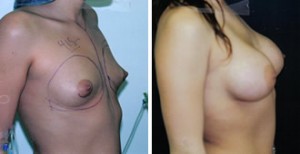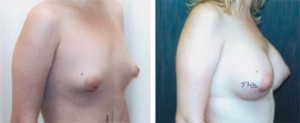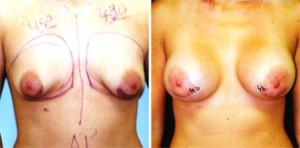Tubular Breast Deformity Hollywood
Posted On: October 21, 2008 Author: The Office of Dr. Stuart Linder Posted In: Home
Congenital Breast Deformity
Tubular breast deformities can be seen in patients throughout the world. In my practice, approximately 2% of patients that have breast augmentation will have some form of tubular breast deformity.
The components of tubular breast deformity include usually:
- a poorly defined inframammary fold, which means the flattening of the lower pole of the breast
- herniation of breast tissue into the nipple areolar complex
- a restricted lower pole of the breast that looks conical in shape rather than a round shape.
We fix these types of breast deformities all the time in our Beverly Hills surgery center. Patients with these deformities do extraordinarily well.
 Breast Implants can normally be placed in the dual plane, half under the muscle and half over. Both saline or silicone breast implants can be used, depending upon patient’s preference. However, the thicker the muscles are with these tubular breast deformities, the better the results of saline implants, you get a rounder and a fuller shape with better anteroposterior projection than you do with silicone.
Breast Implants can normally be placed in the dual plane, half under the muscle and half over. Both saline or silicone breast implants can be used, depending upon patient’s preference. However, the thicker the muscles are with these tubular breast deformities, the better the results of saline implants, you get a rounder and a fuller shape with better anteroposterior projection than you do with silicone.
 So, if a patient has ample amounts of glandular tissue and/or muscle, and you’re going to half under/half over with dual plane, we like to do high profile smooth round saline implants. The inframammary fold needs to be lowered and the lower portion of the breast, the fascia of the breast, needs to be released in a radial striated fashion. This allows the convex breast to become rounded and a beautiful fullness to appear.
So, if a patient has ample amounts of glandular tissue and/or muscle, and you’re going to half under/half over with dual plane, we like to do high profile smooth round saline implants. The inframammary fold needs to be lowered and the lower portion of the breast, the fascia of the breast, needs to be released in a radial striated fashion. This allows the convex breast to become rounded and a beautiful fullness to appear.
 Postoperatively, the patients need an upper pole band for a prolonged period of time, up to six to eight weeks, in order to maintain the implant’s position inferiorly with lowering the pocket and allowing the shape to become rounded
Postoperatively, the patients need an upper pole band for a prolonged period of time, up to six to eight weeks, in order to maintain the implant’s position inferiorly with lowering the pocket and allowing the shape to become rounded
The pseudoherniated breast tissue sometimes, if it is severe, can be removed upon opening the periareolar incision in the approach. This can reduce the protrusion of the breast and the conical shape, if necessary. That tissue should be sent to pathology. All glandular breast tissue specimens should be diagnosed by a Board Certified Pathologist
We enjoy doing tubular breast deformities all the time. We have a gallery of tubular breasts in our photo gallery on www.drlinder.com. We invite your questions at any time and look forward to hearing from you.